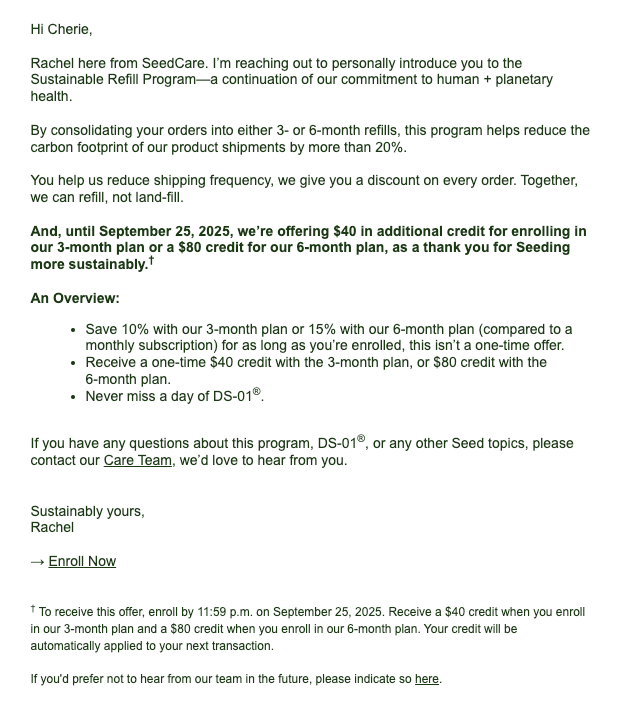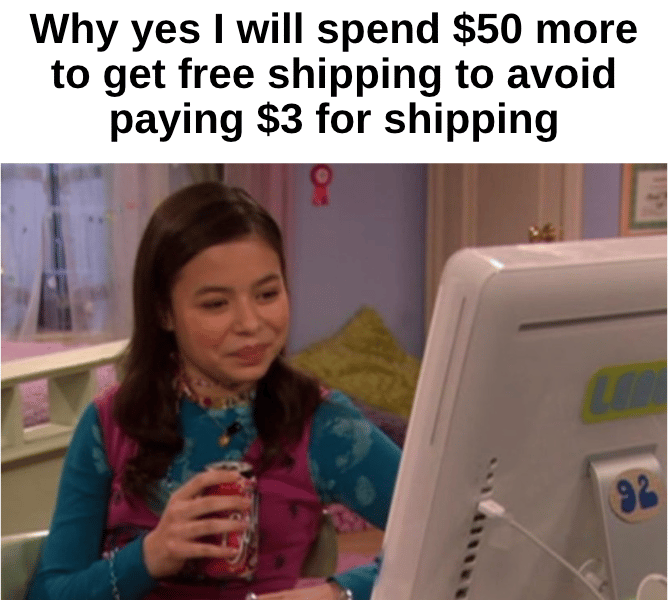- eCom Email Marketer
- Posts
- Seed's Post-Purchase Flow: Education, Trust, and Subscription Stickiness
Seed's Post-Purchase Flow: Education, Trust, and Subscription Stickiness
We just dropped community pricing from $99/month to $99/year » Join the network of retention marketers worldwide
Seed doesn’t just sell probiotics. They build a whole ecosystem around science, sustainability, and education.
Their post-purchase flow reflects that mission, guiding customers through what to expect in the first days, reinforcing the brand’s eco-friendly commitments, and layering in rewards to keep subscribers engaged. It’s more than onboarding - it’s a crash course in becoming part of Seed’s community.
But even with such a thoughtful approach, there are spots where the flow feels overly clinical or misses chances to highlight customer stories.
Here’s our full breakdown of what’s working, what needs refining, and how other brands can apply Seed’s strategy to their own retention playbook.
Also inside:
✔️ Turn Retention Into a Repeatable Revenue Channel
✔️ AI Power-Up: The BFCM Heatmap
Let’s jump in👇.
Seed Post-Purchase Flow: Education, Trust, and Subscription Stickiness
Seed doesn’t just sell probiotics. They sell science, sustainability, and membership into something bigger. Their post-purchase flow doubles down on education, setting expectations for the customer journey while weaving in sustainability commitments and community perks.
It’s a sophisticated strategy that makes new subscribers feel both informed and part of a mission. Still, even strong flows have room to grow.
1. Arrival: The Unboxing Experience
Focus: Educating customers on Seed’s eco-friendly packaging and how to start their probiotic.

Why This Works:
✅ Clear breakdown of each packaging element (refill jar, algae paper, biodegradable foam)
✅ Connects packaging choices directly to sustainability values
✅ Sets usage expectations with a simple day-by-day acclimation protocol
What Needs Work:
❌ The eco-packaging explanation is detailed but could link more explicitly to product benefits (health + planet = why Seed is different)
❌ Visuals feel functional, and adding customer unboxing photos could create more connection
2. Begin: What to Expect in the First Days
Focus: Setting expectations for daily use and possible adjustment periods

Why This Works:
✅ Normalizes “acclimation” symptoms, reducing churn from early drop-off
✅ FAQ style copy is practical and easy to skim
✅ Highlights both immediate and long-term benefits
What Needs Work:
❌ Language is heavy on disclaimers; softening with community testimonials could reassure customers
❌ Visuals show capsules, but lifestyle imagery could make it feel less clinical
3. SciCare Check-In
Focus: A personalized email from the SciCare team about adjustment and support

Why This Works:
✅ Adds a human touch from Seed’s in-house experts
✅ Tactical tips (split doses, take with meals, journaling) are genuinely helpful
✅ Reassures customers they can reach out directly with questions
What Needs Work:
❌ Copy reads like medical advice, and toning it down could make it feel more approachable
❌ Could highlight community channels (like social groups) for peer reassurance
4. Sustainable Refill Push
Focus: Introducing customers to Seed’s 3- and 6-month refill subscription

Why This Works:
✅ Aligns cost savings with environmental values, a smart dual incentive
✅ Incentive of $40–$80 credit sweetens the switch to longer-term commitment
✅ Strong “refill not landfill” messaging ties back to brand purpose
What Needs Work:
❌ Messaging is incentive-heavy and could connect the plan back to customer wellness outcomes (consistency = results)
❌ Email design leans more advocacy than commerce and might miss conversions without a clearer CTA path
5. Rewards + Education Reminder
Focus: Reinforcing Seed’s member community and rewards program

Why This Works:
✅ Clever tiered education (Nerdy, Nerdier, Nerdiest) makes science fun
✅ Rewards points for refills encourage retention and repeat purchasing
✅ Reminder of refill shipping builds trust through transparency
What Needs Work:
❌ Education is positioned as optional “extras” and could be reframed as core to the customer journey
❌ The email buries rewards below copy; flipping the order might improve engagement
What Seed Gets Right
Education as Retention: Seed normalizes the customer journey, pre-empting churn triggers like early discomfort or confusion
Mission-Driven Messaging: Every touchpoint ties back to sustainability and science, strengthening brand trust
Multi-Layered Value: Savings, eco-impact, education, and rewards all work together to lock in long-term subscribers
Where They Miss the Mark
Too Clinical at Times: Dense copy and scientific framing can feel intimidating instead of inviting
Light on Human Stories: Customer testimonials or community voices would soften the science and add credibility
CTAs Get Lost: Sustainability and education messaging sometimes overshadow clear action steps
Final Takeaway:
Seed proves post-purchase emails don’t have to be transactional. They can onboard, educate, and deepen brand alignment all at once. Their flow sets a new bar for retention marketing in wellness, blending science and sustainability into a sticky subscription strategy.
Key Takeaways for Brands
✔️ Use education to set expectations and reduce early churn triggers
✔️ Align product benefits with mission-driven messaging for stronger trust
✔️ Pair discounts with values-based incentives to drive longer-term commitments
✔️ Add community or testimonial touchpoints to balance clinical content with human connection
✔️ Keep CTAs clear and visible, even when layering in advocacy or education
Turn Retention Into a Repeatable Revenue Channel
Most brands treat retention like a reaction:
Sales dip → panic → discount.
But real retention is built before things go quiet... with consistent, intentional campaigns that keep your list warm and your customers coming back.
We put together a free 7-part email series to help you build a year-round retention system you can rely on.
Inside, you’ll get:
✅ Gift guides you can run every month
✅ Flash sales that create urgency (without fatiguing your list)
✅ Campaigns tied to real customer behavior and goals
✅ Loyalty, referral, and review plays that drive repeat revenue
✅ Segmentation strategies and metrics that keep you consistent
Access the Year-Round Retention Playbook for free and turn your quiet months into your highest performers.If you’ve been on the fence, this is the moment.
🙃 Meme Drop

🤖 AI Power-Up: The BFCM Heatmap
Black Friday and Cyber Monday aren’t just about the offer... it’s about when you hit send.
Send too early and shoppers forget you.
Send too late and you’re buried in inbox chaos.
AI can help you time it right with a data-driven heatmap.
Here’s how:
Export last year’s November campaign data (email + SMS).
→ Include open rate, CTR, conversion, and revenue by day and time.
Drop it into ChatGPT with this prompt:
“Analyze this November campaign data. Identify the top 5 days/times where my audience engaged most. Recommend the best windows for my BFCM campaigns this year, and suggest how to stagger sends across email and SMS.”
AI will highlight patterns like:
“Opens peaked Thanksgiving evening; prime time for early access.”
“SMS clicks surged on Black Friday morning between 8–11am.”
“Conversions held strong Cyber Monday afternoon - lean into urgency here.”
Use those insights to heatmap your campaign calendar, ensuring every send hits when customers are most primed to buy.
The result: Instead of guessing send times, you’ve got a battle plan. Your BFCM campaigns cut through the noise because they land at the moments your audience is proven to engage.
Annnnd that’s a wrap for this edition!
Thanks for hanging with Chase and me. Always a pleasure to have you here.
If you found this newsletter helpful (or even just a little fun), don’t keep it to yourself! Share ecomemailmarketer.com with your favorite DTC marketer. Let’s get them on board so they don’t miss next week’s drops.
Remember: Do shit you love.
🤘 Jimmy Kim & Chase Dimond
PS - Your next best customer might be reading this right now. Want in? Email Jimmy to sponsor this newsletter and more.
Love this newsletter but want to receive it less frequently? Let us know by clicking here!


Reply